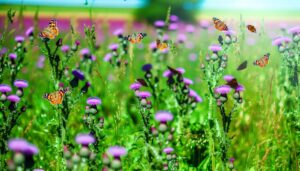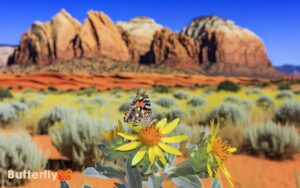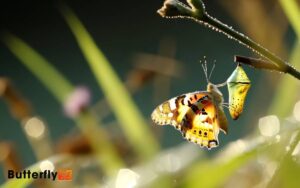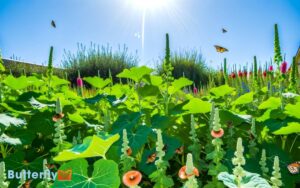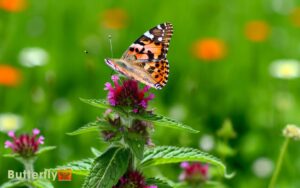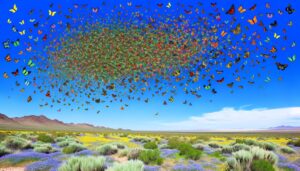Host Plant for Painted Lady Butterfly: Essential Habitat!
The Painted Lady butterfly relies heavily on specific host plants for its lifecycle. Key species include thistles (Cirsium vulgare, Carduus nutans), which thrive in sunny, well-drained soils, and provide high nutritional content.
Mallows offer broad, lobed leaves ideal for larval feeding, while hollyhocks, with their rich soil requirements, support vibrant larval development.
These plants supply essential amino acids, proteins, and carbohydrates, critical for larvae growth and survival. Ideal cultivation involves ensuring well-drained soil, full sunlight, and avoiding pesticides.
Such conditions maximize Painted Lady populations and enhance their lifecycle success. Discover more detailed insights into fostering these butterflies’ habitats.
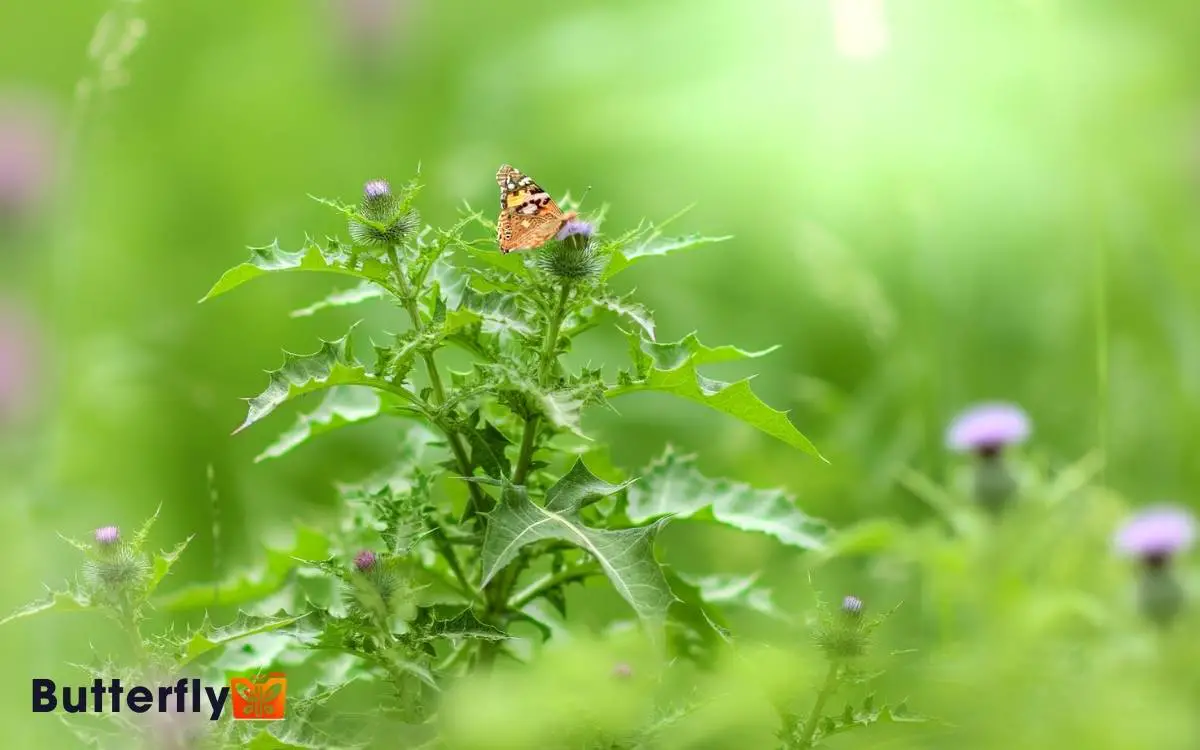
Key Takeaways
Importance of Host Plants
Additionally, host plants are critical to the Painted Lady butterfly’s lifecycle, providing essential nutrients for the larvae to grow and develop. These plants supply the necessary amino acids, proteins, and carbohydrates essential for larval growth stages.
The larvae, or caterpillars, exhibit specialized feeding behaviors that maximize nutrient intake from these host plants. Efficient nutrient absorption impacts their survival rates and successful metamorphosis into adult butterflies.
Furthermore, host plant selection is influenced by the chemical composition of the plant tissues, which can deter or attract larvae.
The presence of specific secondary metabolites in host plants can either facilitate larvae growth or provide a natural defense mechanism against herbivory.
Understanding these interactions helps in conserving Painted Lady populations and their natural habitats.
Favorite Plant Species
Among the preferred host plants for the Painted Lady butterfly, members of the Asteraceae family, such as thistles and sunflowers, are particularly favored due to their high nutritional content and suitable chemical profiles.
These plants provide essential nutrients required for larval development and adult vitality. The species within this family offer a variety of textures and structures that cater to different stages of the butterfly’s lifecycle.
Painted Lady butterflies exhibit selective oviposition behavior, choosing plants that maximize survival rates.
- Thistles (Cirsium spp.): High nutritional value and protective spines.
- Sunflowers (Helianthus spp.): Rich in nectar and pollen.
- Mallows (Malva spp.): Soft leaves suitable for larvae.
- Nettles (Urtica spp.): Offer essential minerals.
- Hollyhocks (Alcea spp.): Abundant foliage and flowers.
Understanding these preferences aids in conservation and habitat enhancement efforts.
Thistle Varieties
Thistle varieties such as Cirsium vulgare and Carduus nutans serve as vital host plants for the Painted Lady Butterfly.
These species thrive in well-drained soils and open, sunny habitats, providing ideal conditions for larval development.
Understanding the specific growing conditions of these thistles can enhance conservation efforts for this butterfly species.
Common Thistle Species
Several species within the genus Cirsium, commonly known as thistles, serve as significant host plants for the Painted Lady butterfly. These thistles provide essential resources for larval development and adult nourishment.
Key species include:
- Cirsium vulgare: Known as the bull thistle, this species features spiny leaves and purple flower heads.
- Cirsium arvense: Commonly referred to as the Canada thistle, it spreads through rhizomes and boasts small, clustered flowers.
- Cirsium palustre: The marsh thistle thrives in wet environments and displays dark purple florets.
- Cirsium discolor: Known as the field thistle, this plant has pale pink to lavender flowers and densely hairy stems.
- Cirsium horridulum: Also called bristly thistle, it’s characterized by its robust spines and yellow to red flowers.
These thistles are integral to sustaining Painted Lady populations.
Thistle Growing Conditions
Understanding the specific growing conditions required for various thistle species is essential for optimizing their role as host plants for the Painted Lady butterfly.
Thistles, including Cirsium and Carduus genera, thrive in well-drained soils with moderate to low fertility. They prefer full sun exposure but can tolerate partial shade. Ideal soil pH ranges from 5.5 to 7.5.
These hardy plants are drought-tolerant once established but benefit from occasional watering during prolonged dry periods. Germination requires stratification, simulating winter conditions.
Regularly disturbed soils, such as those in meadows and roadsides, provide ideal habitats. Monitoring for invasive tendencies is critical as thistles can spread aggressively.
Mallow Species
Mallow species serve as critical host plants for the Painted Lady butterfly, providing essential nutrients and habitat for their larvae. These plants, belonging to the Malvaceae family, are rich in resources that support the growth and development of caterpillars.
The leaves contain crucial proteins and carbohydrates, while the plant structure offers protection from predators and environmental stressors.
Key characteristics of Mallow species include:
- Leaf morphology: Broad, lobed leaves ideal for larval feeding.
- Habitat range: Found in diverse environments, from grasslands to disturbed urban areas.
- Nutrient content: High in essential nutrients, including nitrogen and amino acids.
- Growth patterns: Perennial growth ensures year-round availability.
- Adaptability: Tolerant to varying soil types and climatic conditions.
These attributes make Mallow species indispensable to the Painted Lady butterfly’s lifecycle.
Hollyhock Benefits
Hollyhocks thrive in nutrient-rich soils, which supports their robust growth and enhances their ability to sustain butterfly larvae.
Their diverse and vibrant flower varieties not only create visual appeal but also serve as critical nectar sources for pollinators.
Nutrient-Rich Soil Requirements
Nutrient-rich soil enhances the growth of hollyhocks, providing an ideal environment that supports the Painted Lady butterfly’s lifecycle.
Such soil promotes robust root development and excellent plant health, which directly benefits the butterflies by guaranteeing a consistent and nutrient-dense food source for their larvae.
Key soil components include:
- Organic Matter: Improves soil structure, water retention, and nutrient availability.
- Nitrogen: Essential for leaf growth and overall plant vigor.
- Phosphorus: Critical for root development and energy transfer within the plant.
- Potassium: Boosts disease resistance and overall plant health.
- pH Balance: Maintains nutrient availability; hollyhocks thrive in slightly acidic to neutral soil (pH 6.0-7.0).
Understanding these soil requirements can greatly enhance hollyhock cultivation and, consequently, Painted Lady butterfly conservation.
Attractive Flower Varieties
Why do certain hollyhock varieties exhibit strikingly vibrant blooms that not only attract the Painted Lady butterfly but also enhance the aesthetic value of gardens?
The answer lies in their genetic composition and pigment concentration. Hollyhocks (Alcea spp.) possess high levels of anthocyanins and flavonoids, which result in vivid coloration. These pigments are essential for attracting pollinators, including the Painted Lady butterfly.
Additionally, hollyhocks’ large, open flowers provide easy access to nectar, a critical food source for butterflies. Their vertical growth habit also maximizes space, allowing for dense, colorful displays that are visually appealing.
Consequently, gardeners favor hollyhocks for their dual role in supporting butterfly populations and adding ornamental value to landscapes.
Pollinator-Friendly Environment
A pollinator-friendly environment is created by the strategic use of plants like hollyhocks, which offer abundant nectar and serve as important feeding stations for butterflies and other pollinators.
Hollyhocks (Alcea spp.) are biennial or short-lived perennials that bloom profusely, attracting a variety of pollinators due to their high nectar production and vibrant colors. Their tall, sturdy stems support large, cup-shaped flowers that provide easy access to nectar.
- High nectar content: Provides a reliable food source for pollinators.
- Extended blooming period: Offers sustenance over a longer time frame.
- Vibrant, eye-catching colors: Attracts a diverse array of pollinators.
- Vertical growth habit: Maximizes space and provides shelter.
- Adaptability: Thrives in various soil types and climates, enhancing pollinator habitats widely.
These benefits make hollyhocks an excellent choice for a pollinator-friendly garden.
Cultivation Tips
To successfully cultivate host plants for the Painted Lady butterfly, gardeners should guarantee ideal sunlight exposure and well-draining soil conditions. Host plants like thistles, mallows, and hollyhocks thrive in full sun, requiring at least six hours of direct light daily.
Soil should be lightweight, rich in organic matter, and capable of maintaining moderate moisture levels without becoming waterlogged. Proper spacing ensures good air circulation, reducing disease risk.
Regularly monitor for pests like aphids, which can harm plant health. Implementing a mulch layer can help retain soil moisture and regulate temperature.
Fertilize sparingly, using a balanced, slow-release formula to avoid excessive nitrogen, which can deter butterfly larvae. These practices guarantee robust plant growth, supporting the Painted Lady butterfly’s life cycle.
Supporting Local Populations
In enhancing local populations of Painted Lady butterflies, gardeners must focus on creating diverse habitats that offer ample nectar sources and undisturbed breeding grounds. This involves planting a variety of host and nectar plants to support different life stages of the butterfly. Additionally, selecting the right plants is crucial to ensuring a sustainable environment for these butterflies. A great starting point is to incorporate 7 plants for Painted Lady butterflies that provide both nourishment and suitable egg-laying sites. By carefully curating these plant choices, gardeners can help maintain a thriving butterfly population throughout the seasons.
Key practices include:
- Selecting native plant species: Native plants are more likely to thrive and support the local ecosystem.
- Providing continuous blooms: Guarantee there’s a succession of flowering plants from spring through fall.
- Maintaining pesticide-free zones: Avoid chemicals that could harm butterflies and their larvae.
- Creating sheltered areas: Dense plantings and shrubs offer protection from predators and harsh weather.
- Ensuring water availability: Shallow water sources help with hydration and nutrient intake.
These strategies aid in sustaining vibrant local butterfly populations.
Conclusion
To summarize, the selection of specific host plants plays a vital role in the painted lady butterfly‘s lifecycle. By cultivating thistle, mallow, and hollyhock, gardeners can support these butterflies’ development and local populations.
Isn’t it remarkable how a simple choice in plant species can foster such biodiversity?
Understanding the symbiotic relationships between butterflies and their preferred plants allows for a more scientifically informed approach to conservation and gardening practices, ensuring these vibrant insects continue to thrive.

